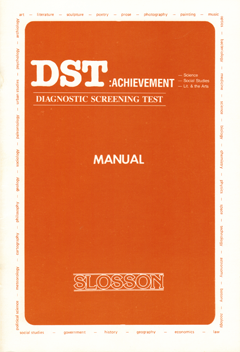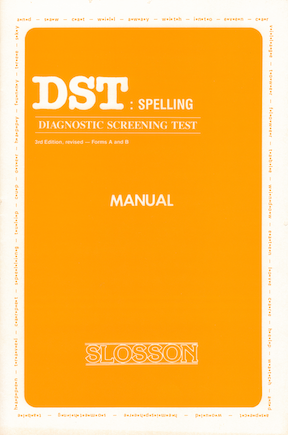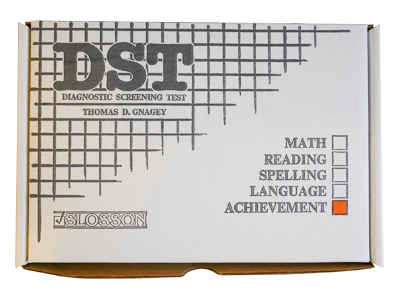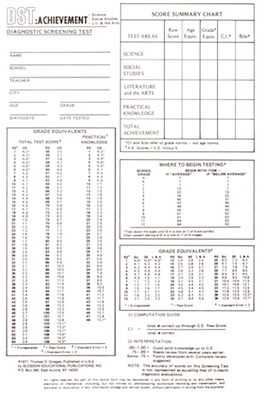Order the Entire DST Battery and Save!
Diagnostic Screening Test: Achievement
Quantity Instructor Discount Available for the DSTA.....Refer to Promos Page
The DSTA is designed as a quick, valid method for estimating practical data about student’s over all school achievement level in general, and achievement in Science, Social Studies and Literature and the Arts more specifically. Several generally adequate short tests are readily available for assessing the basic skill areas (math, reading and spelling). Since it is also important to be able to obtain quick, reliable estimate of “content” area achievement, the need for a test such as this seems evident. A quick method for obtaining data from which to make practical suggestions for classroom motivation procedures (high incentive value material and activities) is also a useful part of most evaluations. Suggestions of that nature can be formulated from the score pattern on this test.
Five Major Areas Assessed in the DSTA:
1. Total Achievement or General Knowledge Level:
A student’s general knowledge about the world (as related in scientific, social, literary and artistic areas) is tapped. When these results are presented as age equivalent scores, an estimate of mental age is obtained.
2. Practical Knowledge Level: Two types of information are sampled, Formal (pure/abstract) and Practical. The Practical Knowledge subtest reflects that which is more useful and applicable in one’s daily living activities and which is culturally expected as general knowledge of the literate person.
3. Science Achievement (Sci) Subtest: This section taps science facts, concepts and related content material in a developmental sequence fairly typical of current science programs across the United States.
4. Social Studies (SS) Subtest: This subtest strives to isolate, again in developmental sequence, major concepts and content material typically known by children about history, geography, government and related areas. It reflects educational content in U.S. schools and culture.
5. Literature and the Arts (L&A) Subtest: Combined in this section are those aspects of one’s formal and informal education typically reflective of the “cultured” individual - literature, Art, Architecture, Music and related topics. A low score on this subtest (relative to other area subtests) frequently indicates a child sociologically defined as lower class- culturally less advantaged.
Consolidation Index (CI) Computation:
The Consolidation Index (CI) reflects how solid or spotty a student’s knowledge or skill is. It is more accurate in areas which readily lend themselves to graded, developmentally sequenced skill items such as reading, math and spelling. Experience shows it is a useful concept in relation to general knowledge or “School Achievement,” in a broad sense, also.
Interpretation of Data:
A student’s total, over-all general achievement in content areas is suggested by the Total Test Score, which can be meaningful in general screening procedures. Althought it is of little importance when it comes to planning specific classroom programs, the DSTA can be useful when used as a base line for comparison with content area scores. An estimate of a child’s mental age can be obtained by using the Total Test Age Equivalent (AE) Score. Any interpretation aimed at making recommendations for procedures, activities or entry level for instructional purposes should include the utilization of the CI.
Test Construction:
The initial pool of over 900 items was obtained from sampling “end of chapter” tests in a variety of science, social studies, and literature series from grades K-12, and by having teachers at each grade level submit several item topics which they thought represented “first time introduced for mastery concepts.” Items for music and the arts were drawn from suggestions of experienced teachers, item topics in other available informal tests and inventories, developmental placement of concepts in curriculum guides.
Thomas D. Gnagey / Patricia A. Gnagey
Grades: 1 through Junior College
Administration: Individual; 5 to 10 minutes










